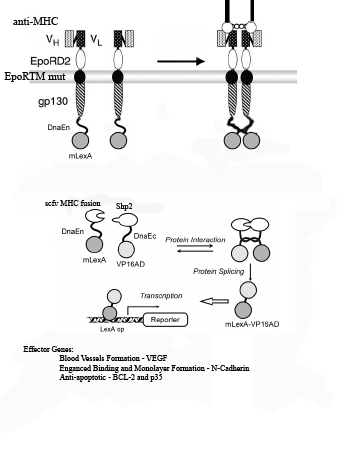Anti-Myosin Heavy Chain Targeting and Signaling
From 2007.igem.org
How It works
1) Myosin Heavy Chain (MHC) is exposed on infarcted heart tissue.
2) scFv chimeric receptor to MHC binds to a repeated domain of MHC
3) EporD2 facilitates the dimerization of the chimeric receptors
4) EporTM mutant version inhibits ligand independent dimerization of the chimeric receptors
5) gp130i becomes activated and JAK's phosphorylate tyrosines on gp130i, including Y759.
6) Shp2-mLexA-dnEN binds to phosphorylated Y759 of gp130i
7) Shp2-mLexA-dnEN comes in close proximity to the dnaEC-VP16 fused to the c-terminal of the gp130i
8) dnaEN and dnaEC, part of the split intein system, undergo peptide processing resulting in the release of newly constituted fusion transcription factor mLexA-VP16
9) mLexA-VP16 translocates to the nucleus where it binds to minimal promoters containing lexA operators to switch on expression N-Cadherin, anti-apoptotic genes such as Bcl-XL,p35 and IAP and blood vessel forming VEGF.
